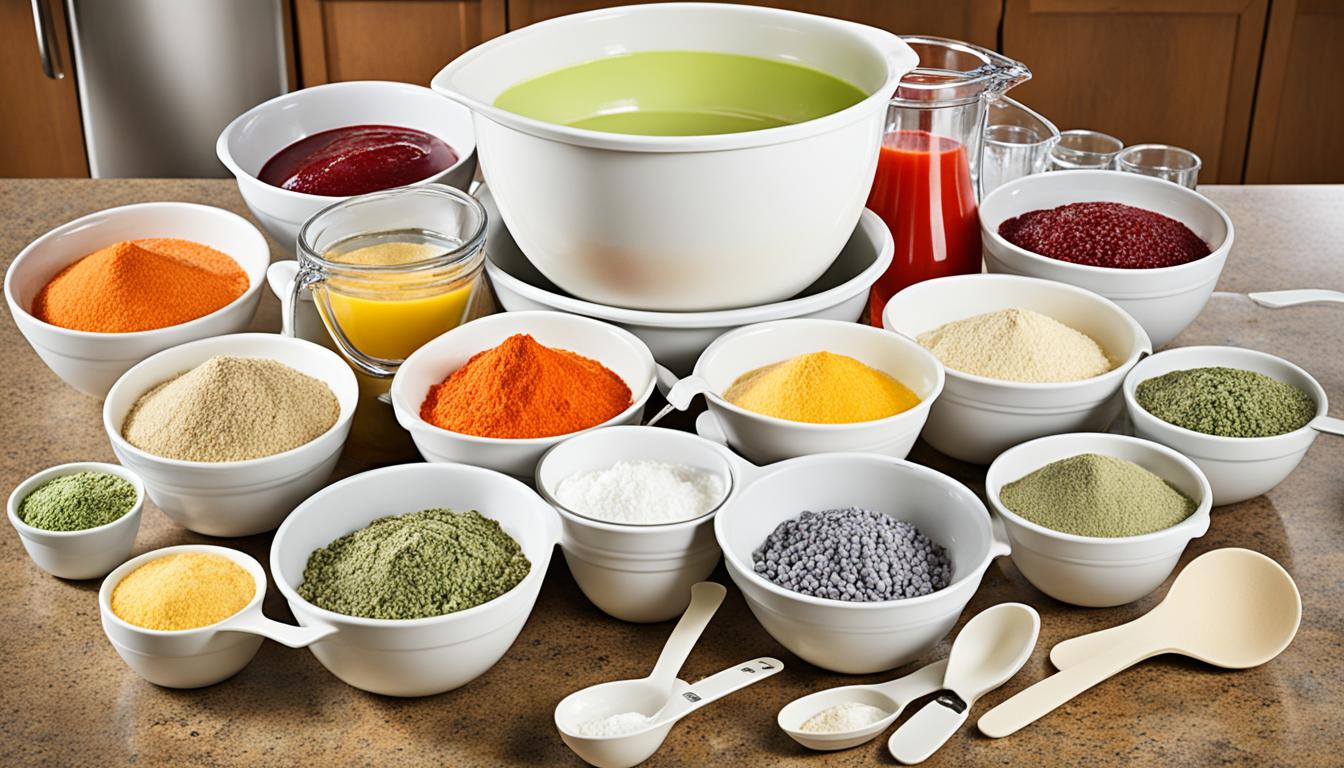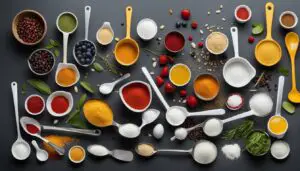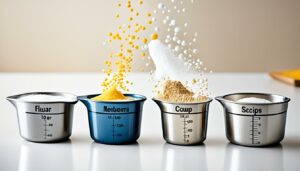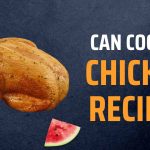Originally posted on February 10, 2024 @ 7:38 am
Have you ever found yourself needing to increase the size of a recipe? Whether you’re hosting a large family gathering or running a custom bakery, scaling a recipe can come in handy. So, can you quadruple a recipe? The answer is yes! With the right tools and a little math, you can successfully multiply recipe measurements to meet your needs.
Contents
- 1 Why Scale a Recipe?
- 2 Tools Needed to Scale a Recipe
- 3 First Step: Math Class
- 4 Check Your Volume!
- 5 General Rules for Scaling
- 6 Exact Measurements
- 7 Round Down, Except for Baking
- 8 Conclusion
- 9 FAQ
- 9.1 Can you quadruple a recipe?
- 9.2 How do I increase the size of a recipe?
- 9.3 What tools do I need to scale a recipe?
- 9.4 How do I scale a recipe using math?
- 9.5 What should I consider when scaling a recipe?
- 9.6 Are there any limitations to scaling a recipe?
- 9.7 Why are exact measurements important when scaling a recipe?
- 9.8 Should I round down ingredient amounts when scaling a recipe?
- 9.9 How can scaling a recipe help customize my cooking and baking?
- 10 Source Links
Key Takeaways:
- Scaling a recipe allows you to adjust the yield to cater to different occasions and requirements.
- To quadruple a recipe, you’ll need a digital kitchen scale, knowledge of your mixing bowl’s capacity, and some basic math skills.
- Scaling recipes is useful for custom bakeries, large family gatherings, and small batch baking.
- Consider the limitations of your equipment and the importance of precise measurements, especially in baking.
- Practice and careful calculations will help you scale recipes like a pro and create delicious meals and treats.
Why Scale a Recipe?
Scaling a recipe is a versatile technique that allows you to adjust the yield of a recipe according to your needs. Whether you want to make more or less than the original amount, scaling can be done with ease. This is particularly useful for custom bakeries, large family gatherings, or when you only require a smaller quantity of baked goods for small batch baking. By adjusting the recipe yield, you can customize your cooking and baking to fit your specific requirements.
For custom bakeries, scaling recipes offers the flexibility to produce cakes in different sizes using the same base recipe. This allows for variety and a wider range of options for your customers. Similarly, for large family gatherings or events, scaling up recipes ensures that you can meet the demand for more food without compromising on taste or quality. On the other hand, scaling recipes can also be beneficial for small batch baking, when you only need a smaller quantity of baked goods for personal consumption or a small gathering.
Scaling a recipe not only saves time and effort but also allows for greater customization. Whether you’re increasing or decreasing the recipe yield, you have the freedom to adjust the ingredients and proportions according to your preferences. This means you can experiment with flavors, textures, and even dietary restrictions more easily. Scaling recipes empowers you to take control and create dishes that perfectly cater to your taste buds.
“Scaling a recipe gives you the power to customize your cooking and baking to fit your needs.”
So whether you’re running a custom bakery, hosting a large family gathering, or simply want to enjoy homemade treats in smaller portions, scaling recipes is a valuable skill to have. It allows you to adapt and modify recipes to suit your unique requirements, ensuring that every dish turns out just the way you want it to.
Next, let’s explore the essential tools needed to successfully scale a recipe.
Tools Needed to Scale a Recipe
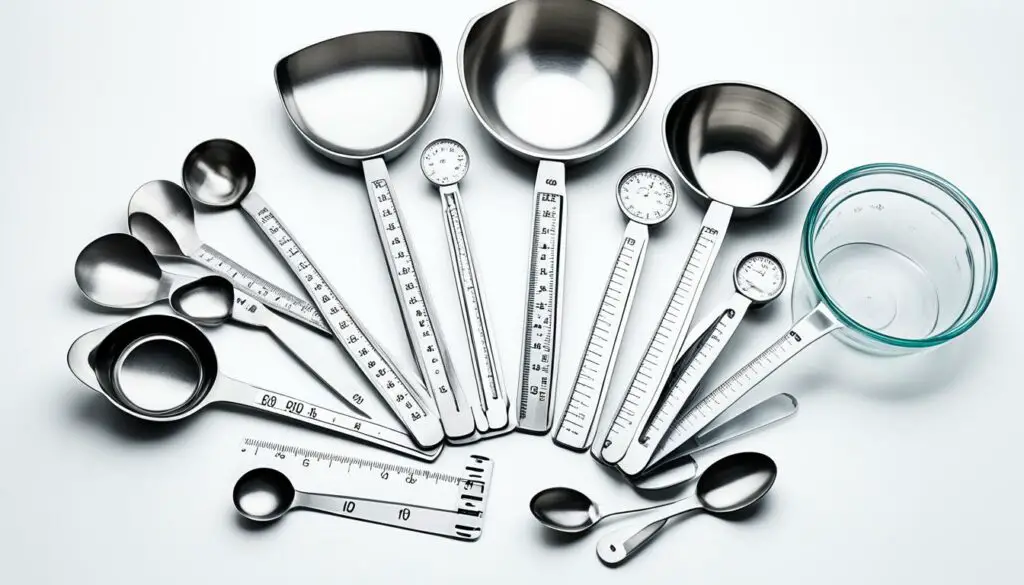
To successfully scale a recipe, you’ll need a few essential tools. Let’s take a look at the important tools you should have on hand before attempting to scale a recipe.
Digital Kitchen Scale
A digital kitchen scale is a must-have tool for accurate measurements when scaling recipes. It allows you to work with metric units, which are more precise when adjusting ingredient amounts. With a digital kitchen scale, you can easily measure ingredients by weight, ensuring consistent results in your scaled recipe.
Measuring Cups and Spoons
Measuring cups and spoons are essential tools for scaling recipes. They allow you to measure ingredients accurately, especially when working with volume measurements. Whether it’s a cup of flour or a teaspoon of vanilla extract, having the right measuring tools will ensure that you maintain the proper proportions when scaling your recipe.
Pro Tip: Invest in a set of high-quality measuring cups and spoons to ensure accuracy in your recipe scaling. Look for dishwasher-safe options with clear markings for easy measurement.
Having these recipe scaling tools, including a digital kitchen scale and measuring cups and spoons, will set you up for success when scaling your favorite recipes.
| Recipe Scaling Tools |
|---|
| Digital Kitchen Scale |
| Measuring Cups and Spoons |
First Step: Math Class
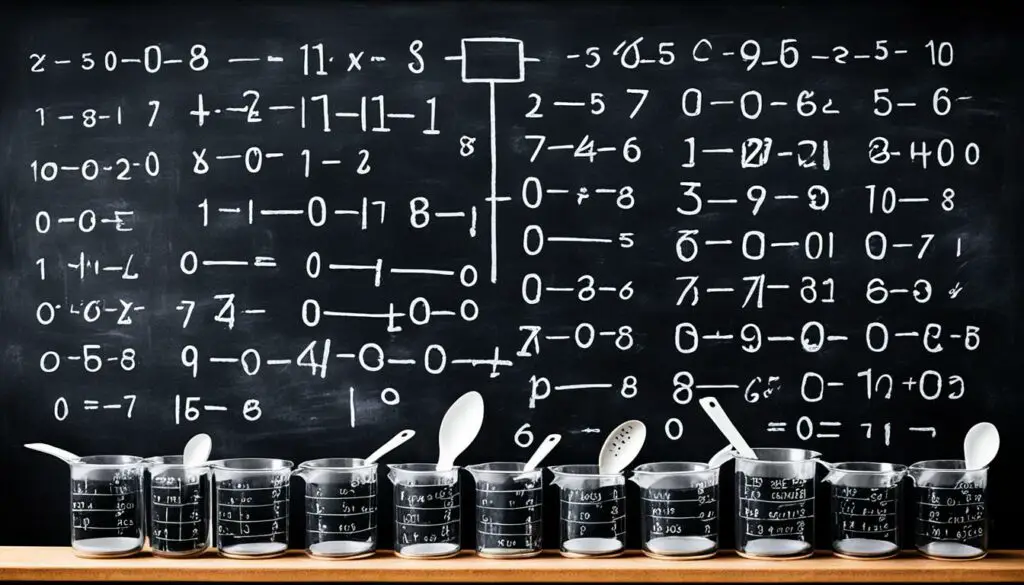
Math is an essential part of scaling a recipe. Before you can begin, you need to determine the original yield of the recipe and decide if you need to increase or decrease it. If you’re looking to quadruple a recipe, you’ll need to multiply each ingredient measurement by four. It’s crucial to double-check your calculations to ensure that you have the correct amount of each ingredient for your scaled recipe.
Scaling recipes requires basic multiplication skills. By understanding the math behind scaling, you can confidently adjust ingredient amounts to achieve the desired yield. Here’s an example:
Original recipe: 1 cup flour
Scaled recipe (quadrupled): 4 cups flour
Conversion Examples
The table below provides some common conversions to help you scale recipes:
| Original Measurement | Scaled Measurement (Quadrupled) |
|---|---|
| 1 teaspoon | 4 teaspoons |
| 1 tablespoon | 4 tablespoons |
| 1 cup | 4 cups |
| 1 pound | 4 pounds |
| 1 ounce | 4 ounces |
Note: These conversions are specific to scaling recipes by quadrupling. For other scaling ratios, adjust the measurements accordingly.
By mastering the math involved in scaling recipes, you’ll gain the confidence to modify any recipe to suit your needs.
Check Your Volume!
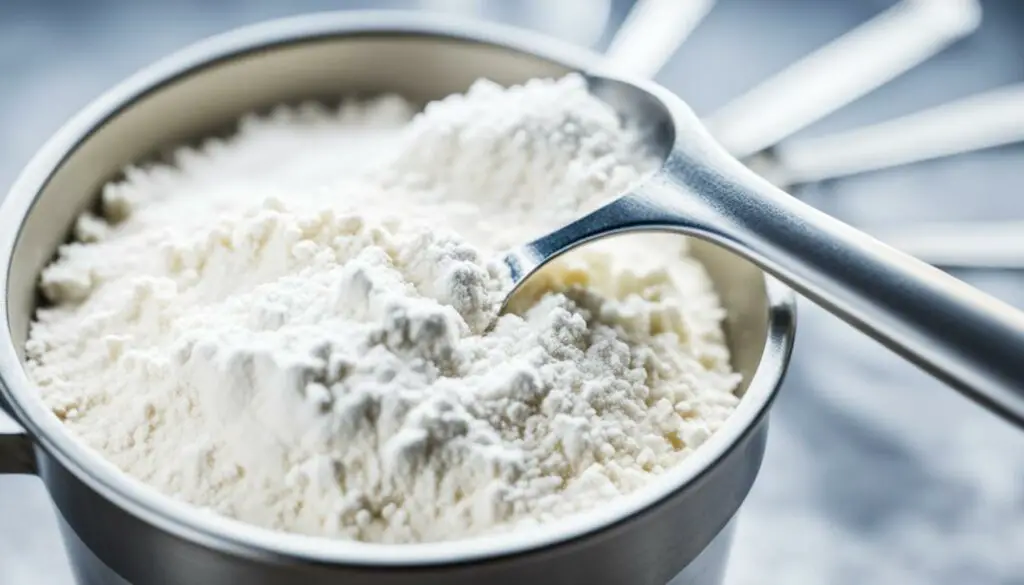
When scaling a recipe, it’s crucial to consider the volume of your ingredients and the capacity of your mixing bowls. Each ingredient and the finished batter or dough will take up space in your bowls. If you’re scaling up a recipe, it’s important to ensure that your mixing bowls can accommodate the increased amount of batter or dough without overflowing.
Overfilling your bowls can lead to messy spills and improper mixing, affecting the texture and consistency of your final dish. To prevent this, it’s essential to know the volume limitations of your equipment and adjust your recipe proportions accordingly.
For successful recipe scaling, here are a few tips to check your volume:
- Start by measuring the capacity of your mixing bowls. This will help you determine how much batter or dough you can comfortably fit without overflowing.
- Keep in mind that different ingredients have varying densities and can expand or contract during the cooking or baking process.
- Pay attention to the size of your ingredients. Chopped or diced ingredients, for example, will take up more space in the bowl compared to whole ingredients.
By considering the volume of your ingredients and the capacity of your mixing bowls, you can ensure that your recipe scaling process goes smoothly, resulting in consistent and delicious dishes every time.
General Rules for Scaling
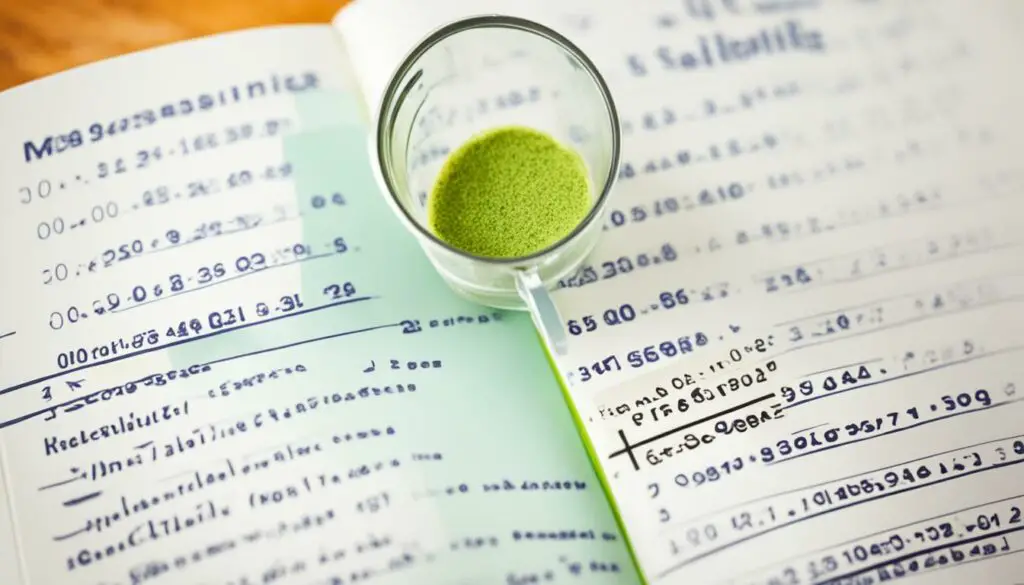
While scaling a recipe can be helpful in many situations, it’s important to understand the rules and limitations involved. Knowing the guidelines for scaling recipes will ensure that you achieve the desired outcome without compromising the taste or texture of the dish.
Rule #1: Consider Equipment Capacity
When scaling a recipe, it’s crucial to take into account the capacity of your equipment, such as mixing bowls or stand mixers. These tools have limitations, and exceeding their capacity can result in poor mixing or messy spills. Always check the specifications of your equipment and adjust the recipe accordingly.
Rule #2: Precision Matters for Baking
While it’s generally safe to round down ingredient measurements when scaling recipes for non-baking purposes, baking requires more precision. Baking is a science, and even slight variations in ingredient amounts can affect the texture and rise of your baked goods. For baking recipes, it’s best to get the adjusted measurements as close as possible to the original ratios.
Rule #3: Some Recipes Can’t be Scaled
Not all recipes are suitable for scaling, especially those that rely on precise measurements or specific techniques. Baking recipes that involve chemical reactions, like cakes or breads, may not yield the desired results when scaled. Additionally, recipes that require specific ratios of ingredients or cooking times may not work well when adjusted. It’s essential to understand the limitations of certain recipes and use your judgment when deciding whether or not to scale.
By following these general rules for scaling recipes, you’ll be able to achieve successful results and customize your cooking to suit your needs. Remember to consider the capacity of your equipment, be precise in your measurements for baking, and respect the limitations of certain recipes. Scaling can be a useful tool in the kitchen, but it’s important to approach it with knowledge and care.
Exact Measurements
When it comes to certain recipes, especially those involving baking or candy-making, precise measurements are key. Using weight measurements instead of volume can provide greater accuracy in these situations. If you need to convert a specific measurement, employing a kitchen scale is essential to ensure you get the exact amounts you need. Weight measurements become particularly important when scaling up a recipe, such as doubling or quadrupling the ingredients, as they help maintain the correct proportions. Following these exact measurements is crucial for achieving the desired results in your baked goods.
| Ingredient | Original Recipe | Scaled Recipe (Quadrupled) |
|---|---|---|
| Flour | 2 cups | 8 cups |
| Sugar | 1/2 cup | 2 cups |
| Butter | 1/2 stick | 2 sticks |
| Vanilla Extract | 1 teaspoon | 4 teaspoons |
In the example above, we can see the exact measurements for quadrupling a recipe. By using a kitchen scale, you can accurately measure each ingredient to maintain the proper ratios and proportions. This attention to detail ensures that your baked goods turn out just as delicious as the original recipe, but in a larger batch.
Round Down, Except for Baking
When it comes to adjusting ingredient amounts, rounding down is generally safe if you’re not baking. Most ingredients can handle a slight decrease without significantly affecting the overall outcome of the dish. This flexibility allows for easy customization of recipes based on personal preferences or the availability of ingredients. However, when it comes to baking, precise measurements play a crucial role in achieving the desired texture and rise.
In baking recipes, it’s best to get the adjusted measurements as close as possible to the original recipe. Even slight variations in ingredient amounts can impact the chemical reactions and structure of the baked goods. To maintain consistency and ensure successful results, it’s important to follow precise baking measurements.
For example, let’s say you’re quadrupling a recipe for a batch of chocolate chip cookies. The original recipe calls for 1 cup of chocolate chips. If you round down to 3/4 cup, you might notice a minimal difference in the cookies’ appearance and taste. However, if you round up to 1 1/4 cups, the cookies may become overly sweet and affect their texture during baking.
It’s crucial to pay attention to the proportions and maintain precise measurements, especially in baking. The table below illustrates the importance of precise measurements in a baking recipe:
| Ingredient | Original Recipe Measurement | Quadrupled Recipe Measurement (Rounded Down) |
|---|---|---|
| All-purpose Flour | 2 cups | 1 3/4 cups |
| Sugar | 1 cup | 7/8 cup |
| Baking Powder | 1 teaspoon | 3/4 teaspoon |
| Salt | 1/2 teaspoon | 3/8 teaspoon |
| Butter | 1/2 cup | 7/16 cup |
| Eggs | 2 | 1 3/4 |
| Vanilla Extract | 1 teaspoon | 3/4 teaspoon |
| Chocolate Chips | 1 cup | 7/8 cup |
As you can see from the table, rounding down the measurements helps maintain the proportions of the original recipe while adjusting the quantities to fit a larger batch. This precise approach ensures that the cookies maintain their intended texture and flavor.
It’s also important to note that spices and flavorings, such as cinnamon or vanilla extract, can be adjusted according to personal preference and desired taste. These ingredients often have a more forgiving nature compared to the primary components of a recipe.
So, while rounding down is generally acceptable for non-baking recipes, it’s always best to strive for precise measurements when it comes to baking. This attention to detail will help you achieve delicious and consistent results in your baked goods.
Conclusion
Successfully scaling recipes is a valuable skill that allows you to customize your cooking and baking to meet your specific needs. By following the right steps and using the appropriate tools, you can easily double or quadruple a recipe. It’s important to consider the limitations of your equipment and pay attention to precise measurements, especially in baking.
With practice and careful calculations, you’ll be able to scale recipes like a pro and create delicious meals and treats for any gathering or occasion. Whether you’re adjusting a recipe for a custom bakery order or catering to a large family gathering, recipe customization is within your reach. The ability to modify cooking and baking recipes gives you the flexibility to experiment with flavors and adapt to dietary restrictions.
Remember, scaling a recipe is not just about increasing or decreasing ingredient amounts. It’s about understanding the proportions, maintaining the correct ratios, and achieving the desired results. So, grab your digital kitchen scale, measuring cups, and spoons, and start exploring the possibilities of scaling recipes. Happy cooking and baking!
FAQ
Can you quadruple a recipe?
Yes, you can quadruple a recipe by multiplying each ingredient measurement by four.
How do I increase the size of a recipe?
To increase the size of a recipe, multiply each ingredient measurement by the desired factor.
What tools do I need to scale a recipe?
You will need a digital kitchen scale and measuring cups and spoons to accurately measure ingredients when scaling a recipe.
How do I scale a recipe using math?
To scale a recipe, determine the original yield, decide on the desired yield, and calculate the multiplication factor to adjust the ingredient measurements accordingly.
What should I consider when scaling a recipe?
When scaling a recipe, consider the volume of ingredients and the capacity of your mixing bowls to ensure they can accommodate the increased amount of batter or dough.
Are there any limitations to scaling a recipe?
Yes, the capacity of your equipment and certain recipes’ reliance on precise measurements may limit how much you can effectively scale a recipe.
Why are exact measurements important when scaling a recipe?
Exact measurements, especially in baking or candy making, help maintain the correct proportions of ingredients and ensure proper rising and texture.
Should I round down ingredient amounts when scaling a recipe?
It is generally safe to round down ingredient amounts when not baking. However, in baking recipes, it is crucial to maintain exact measurements for the best results.
How can scaling a recipe help customize my cooking and baking?
Scaling a recipe allows you to adjust the yield to suit your needs, whether you’re cooking for a large group or wanting to make a smaller batch of baked goods.

